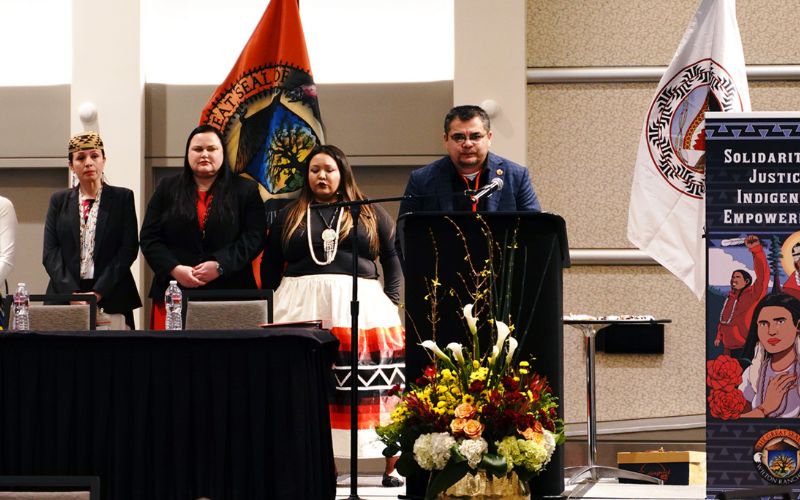
- Details
- By Elyse Wild
For Yurok tribal member Billee Willson, the loss of her mother shaped her life. Her mother, Willson said, adored children. She had six of her own and taught at a Hoopa Valley elementary school. She loved jewelry making and doing beadwork and was exploring basket weaving. She was loved and cared for in her community.
In 1972, when Willson was 15 years old, her mother was shot and killed by her ex-husband.
The death of her mother left Willson and her siblings without an identity. She described moments in life as large, like giving birth to her children, and small, like wondering how to clean stains off a specific fabric. In those moments, she felt the pain of not being able to call her mom.
“We lost connection to our life-giver. It was shocking to all of us,” Willson said at California’ Missing and Murdered Indigenous Peoples (MMIP) Summit on Monday, Feb. 12 in Sacramento.
Willson was one of many Native community members who spoke in front of hundreds of tribal leaders, lawmakers, advocates, and tribal community members at the Summit, sponsored by the Yurok Tribe and Wilton Rancheria.
A crisis
The MMIP crisis is prevalent across the United States, with Indigenous peoples being murdered at a rate 10 times the national average. Homicide is one of the leading causes of death for Native women ages 10-34, according to the Bureau of Indian Affairs.
Advocates say jurisdictional confusion, systemic limitations, and apathy leave many cases unsolved. Devastated families in Native communities are often left to look for their loved ones alone.
California has the fifth-highest number of MMIP cases, the vast majority of which involve young women and girls.Today, at least 20 MMIP cases are recorded yearly in Northern California, but due to limitations in reporting, the actual number is suspected to be significantly higher.
Last week’s Summit brought stakeholders together to explore long-term solutions to the crisis.
Raquel Williams, vice chairwoman of the Wilton Rancheria, and Joe James, chairman of the Yurok Tribe, opened the Summit with a traditional prayer and song from their respective tribes.
William’s comments laid the foundation for the day’s panels, which would examine the intersection of public health, criminal justice infrastructure, and social welfare issues driven by colonialism that have coalesced into the MMIP crisis.
“We must focus on the factors that are contributing to the MMIP crisis, from health care to housing and education; we must recognize and appreciate that this crisis doesn’t have a single cause or an easy solution,” Williams said. “We must not only focus on how we can protect our most vulnerable people; we must work to learn about why this is happening. We strive to identify the underlying causes that result in these shocking numbers, so we must prioritize our resources and funding to support immediate efforts and long-term education and planning.”
James followed Williams, offering his opening remarks and singing a traditional Yurok song about balance.
“What you are going to hear is going to be heavy,” James said. “Use it, take it home, create that change whether it through policy, ordinance or resolution, whether it’s through department funding. This isn’t just to tribes, but everybody in this room. We have a right to be safe.”
The day’s first panel, “Sharing the stories of MMIP, Survivors Families and Advocates,” was moderated by Big Sur Rancheria Chairman Issac Bojorquez. Panelists included Willson, Ronnie Hostler (Round Valley Indian Tribe), Keeley Linton (Mesa Grande Band of Mission Indians), Danielle Vigil-Matson (Hoopa), and Matthew Franklin (Ione Miwok Indians).
Several panelists shared stories of personal loss. Willson spoke of losing her mother and Hostler talked about his granddaughter, who has been missing since 2018. Franklin shared the story of his uncle, who was murdered in 2001.
“We were in a pretty bad place for a long time,” Willson said. “But somehow we all made it to adulthood.”
Linton, the executive director of the nonprofit Strong Hearted Native Women’s Coalition Inc., said policy changes, specialized policing and investigators, tribal data collection and investments in tribal social services are critical to moving the needle. She also advised vigilant vetting of services that claim to offer assistance to families of MMIP as the issue moves into mainstream consciousness.
“I’ve seen it more and more with missing and murdered becoming more (visible) in social media,” Linton said. “There are all of these pop-up Indigenous groups that say they are going to help and are charging families thousands of dollars.”
Vigil-Matson, who has been working on the missing and murdered Indigenous people’s crisis since 2019, noted the intersection of the MMIP crisis and the opioid crisis. Tribal members are going missing after being discharged from rehab, with nowhere to return to, she said.
“One thing I would like to see change is that we create a system so when people are going through these types of circumstances that there are wrap-around services available for them and their families so that when they put them there, they put them in a safe place and make sure they don’t go missing,” Vigil-Matson said.
Justice and policy issues
The day’s second panel was titled “Changing Systems to Address MMIP: Where We Have Been and Where We Are Going?” The panel featured Tribal law enforcement and officials.
Moderator Rosemary Deck, J.D., the chief prosecutor for the Yurok Tribe, kicked off the conversation by asking the panelists to discuss their successes and challenges working across agencies on bringing justice to MMIP cases.
Julie Olivera, an investigator for the Yurok Tribe, noted the successful collaborations between the tribe and the sheriff’s departments of the nearby Humboldt and Del Mar Counties. She also spoke about the difficulty of investigating decades-old cold cases from a time when Native Americans were largely ignored by law enforcement.
California is one of six states that fall under Public Law 280, which cedes jurisdiction over tribal lands from the federal government to the states. The law, passed by Congress in 1953, has left cavernous gaps in law enforcement and did not include any set aside for states to adopt the new jurisdiction. This has left tribal communities in PL-280 states with scant funding and resources for law enforcement and public safety.
Abby Abinati, chief judge of the Yurok Tribal Court, urged tribes to participate in an upcoming study on how Public Law 280, which aims to evaluate tribal criminal justice outcomes in states under the law versus states where jurisdiction of tribal lands lies with the federal government.
“It’s really important that we line up and give them information and recommendations about what has happened to our (criminal justice) infrastructure, or rather what has not happened to our infrastructure because we have had no funding,” Abinati said. “…we (the state and tribes) could be a team, but we have been given no funding to do anything with this jurisdiction.”
“When they send investigators to talk about it, I want you all to be ready to talk about what we don’t have and why we only have one [MMIP] investigator in the whole state — that alone is not okay.”
The Summit’s third and final panel, “Beyond Law Enforcement: Tribal Health, Housing & Supporting Indian Families & to Address MMIP,” brought a public health lens to the crisis.
Virginia Hendrick (Yurok), the executive director of the Consortium for Indian Health, likened the crisis to a disease.
“When you look at the spread of disease, you want to look at the risk factors,” Hendrick said. “The risk factors associated with this [MMIP] are having an encounter with the foster care system, living or being born into poverty, cut off from the traditional food system, lack of traditional law enforcement and lack of western law enforcement, and a grossly underfunded healthcare system.”
Hendrick went on to emphasize that the root causes of the crisis need to be addressed through investments in behavioral health for victims, survivors, and whole families, cultural programming, health services, dental services, economic development, Tribal sovereignty and a fully funded Indian healthcare system.
The Summit concluded in a round table discussion with Tribal leaders from the state’s federally recognized Tribes and lawmakers. Tribal leaders brought their own experiences with the crisis in front of state lawmakers and shared the burden they bear to keep their community safe within a system designed to exclude them.
Yurok Tribe Vice Chairman Frankie Meyers spoke emphatically about the urgent need for funding and resources toward the crisis.
“Every single Tribal member has value, is important. When we see our brothers, our sisters, our mothers go missing, when we don’t see it investigated, when we don’t see it on the news or read about their cases in the newspaper, the feeling we have is that we have no value,” Meyer said.
“I want to thank you all for showing up,” he added, addressing the lawmakers. “You don’t have to be here. You could have ignored us … I’m glad you are here. I’m glad you are joining this discussion to say ‘no more.’”
More Stories Like This
Native News Weekly (August 25, 2024): D.C. BriefsUS Presidents in Their Own Words Concerning American Indians
Montana County Redraws District After Settlement to Ensure Chippewa Cree Votes Count
Tunica-Biloxi Council Member Named to Tribal Leadership Foundation
Ethics Complaint Alleges Former Navajo Nation Chief of Staff Accepted Gifts From Contractor
Help us defend tribal sovereignty.
At Native News Online, our mission is rooted in telling the stories that strengthen sovereignty and uplift Indigenous voices — not just at year’s end, but every single day.
Because of your generosity last year, we were able to keep our reporters on the ground in tribal communities, at national gatherings and in the halls of Congress — covering the issues that matter most to Indian Country: sovereignty, culture, education, health and economic opportunity.
That support sustained us through a tough year in 2025. Now, as we look to the year ahead, we need your help right now to ensure warrior journalism remains strong — reporting that defends tribal sovereignty, amplifies Native truth, and holds power accountable.
 The stakes couldn't be higher. Your support keeps Native voices heard, Native stories told and Native sovereignty defended.
The stakes couldn't be higher. Your support keeps Native voices heard, Native stories told and Native sovereignty defended.
Stand with Warrior Journalism today.
Levi Rickert (Potawatomi), Editor & Publisher


